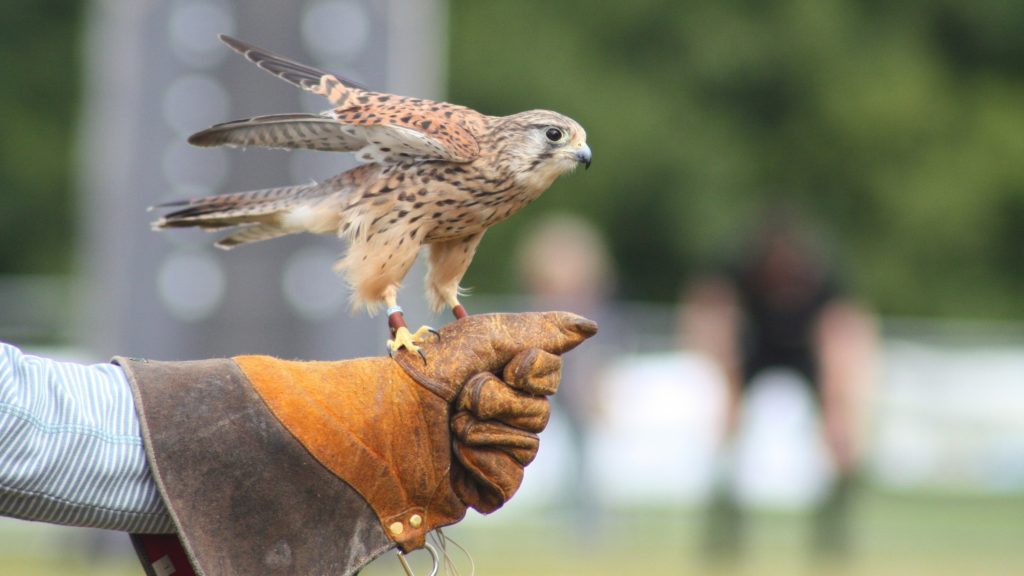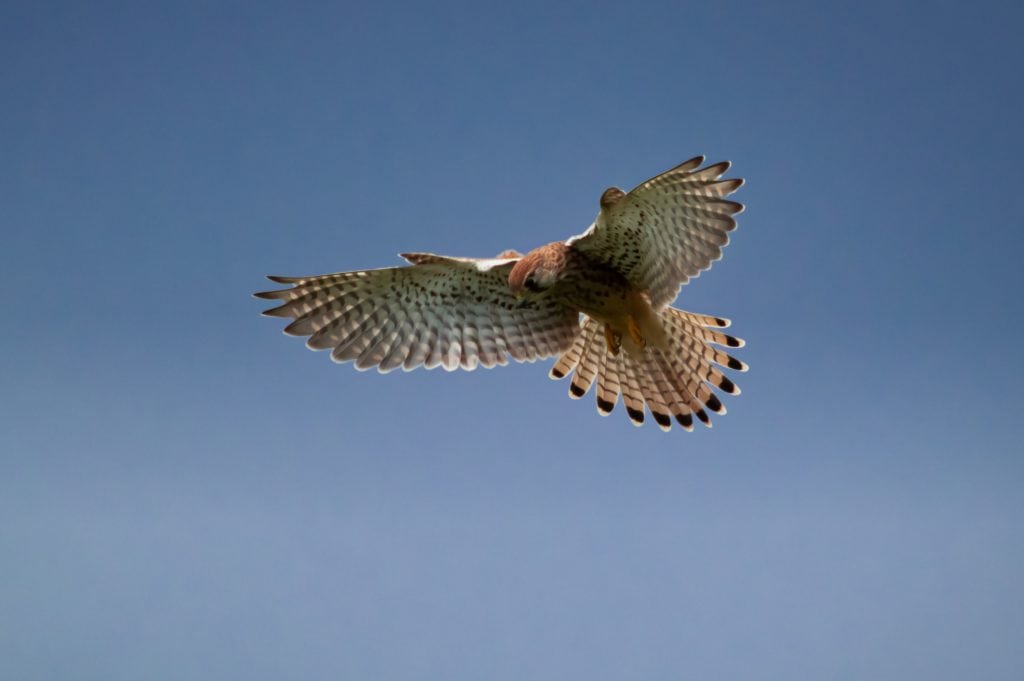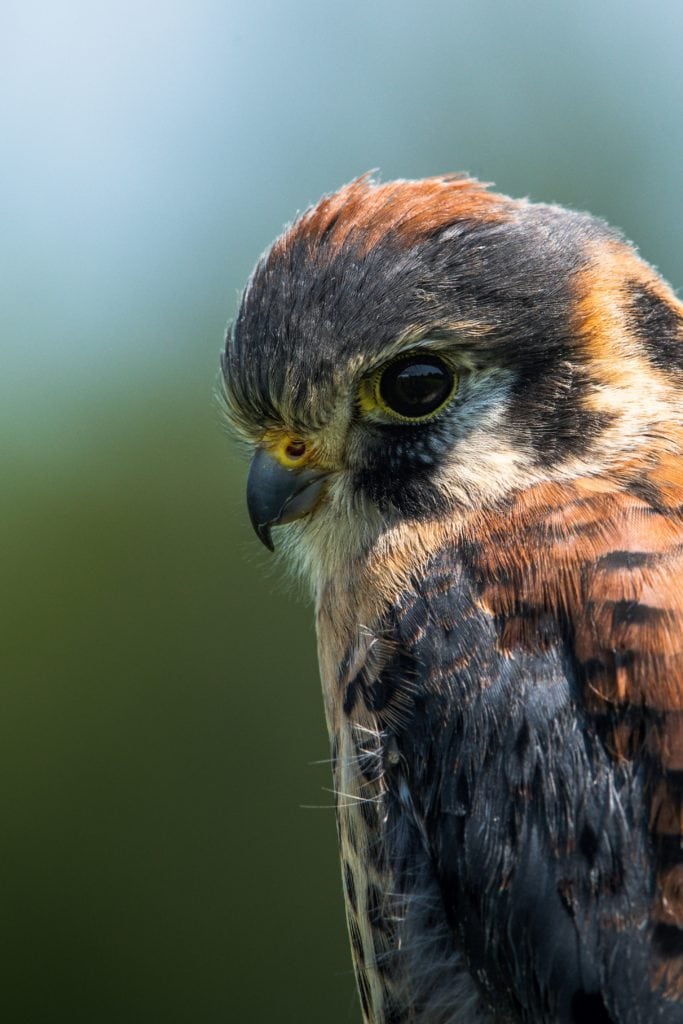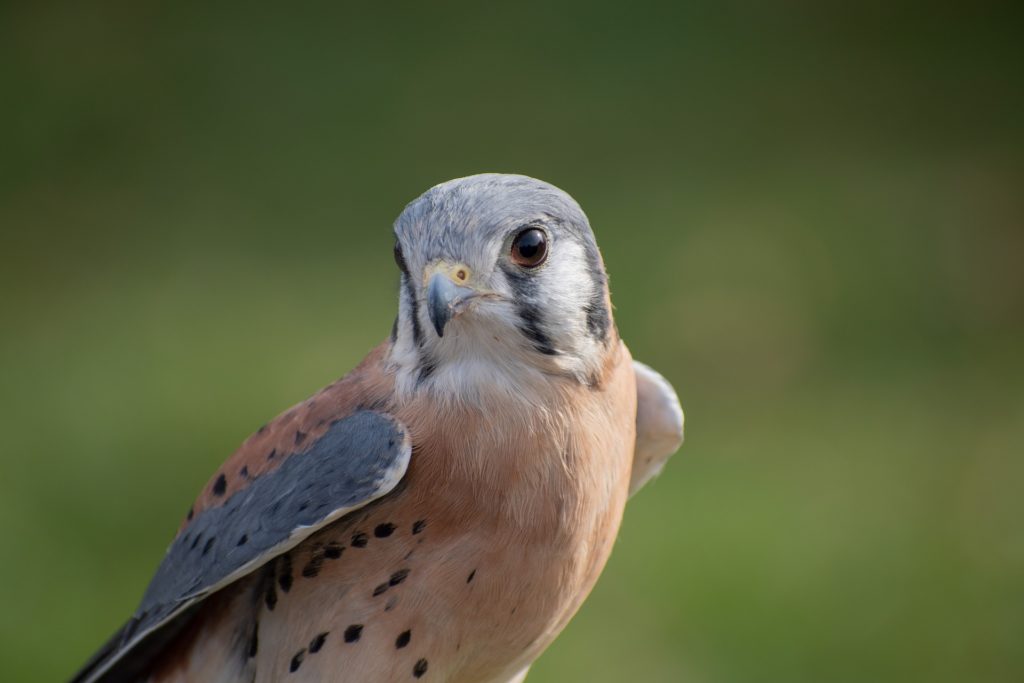The poet Ted Hughes wrote of the kestrel: “Effortlessly at height hangs his still eye./ His wings hold all creation in a weightless quiet/ Steady as a hallucination in the streaming air.” (1) Hughes was not alone in taking inspiration from the mighty kestrel. Kestrels are small members of the falcon family which are best known for their tendency to hover high in the air before swooping down to their prey. Kestrels are also sometimes referred to as “Windhovers” due to this behavior. The kestrel is a common symbol of nobility, ferocity, speed, and might.
Birds of prey often hold prominent places in the traditions of various cultures. The kestrel may be smaller in stature than most of its raptor peers, however this does not diminish the impact of these exceptional birds. In many cases, this bird is associated with vigilance, protection, and vision. Additionally, Hughes is one of many artists and poets who have found inspiration in the regal beauty of the kestrel.
If this bird of prey has an important role in your life, or if you are curious about the rich history of kestrels in art and stories, read on to learn more about the brilliance of the kestrel.
Kestrel Symbolism and Meaning
One fifteenth century manuscript refers to kestrels as falconry birds; that is, birds that hunters nurture and train use to catch prey. Falconry has a long and complex history and is still practiced today. In the fifteenth century, falconry was a leisure activity which was undertaken by nobles especially. According to the above mentioned manuscript, though, kestrels were the lowest of falconry birds, and were associated with the lower tiers of society. “An Eagle for an Emperor, a Gyrfalcon for a King; a Peregrine for a Prince, a Saker for a Knight, a Merlin for a Lady; a Goshawk for a Yeoman, a Sparrowhawk for a Priest, a Musket for a Holy water Clerk, a Kestrel for a Knave.” (2)
So, kestrels can be connected with the noble pursuit of falconry, however, perhaps due to their smaller size, they can also be connected with “knaves.” Knave typically refers to a dishonest person, though in this context it is much more likely that it refers to a person of low birth, such as a peasant or a servant.

Although this manuscript treats kestrels as less desirable than other raptors, many artists and storytellers disagree. In his poem, The Windhover, Victorian poet Gerard Manley Hopkins describes the incredibly moving experience of watching the kestrel in flight. “Brute beauty and valour and act, oh, air, pride, plume, here/ Buckle! AND the fire that breaks from thee then, a billion/ Times told lovelier, more dangerous, O my chevalier!” (3)
Common themes associated with kestrels include prophecy, foresight, wisdom, dreams and visions, vigilance, protection, power, and cunning.
Kestrel Native American Symbolism
In Native American traditions, the kestrel is connected with sharp wittedness, patience, hunting prowess, and stoicism. Like many other birds of prey, the kestrel can also be connected with power, justice, and the forces of nature.
Kestrel Christianity Symbolism
In the Bible, kestrels are among the many birds that are unfit for Christians to eat because kestrels are falcons. (4) For this reason, kestrels may be considered “impure” or “unclean.”
Kestrel Celtic Symbolism
The Irish name for the kestrel is “pocaire gaoithe.” This means “wind-frolicker.” Celtic cultures would associate the kestrel with its incredible and effortless flying ability. This bird is a symbol of the joy and wildness of the vast and untamable sky.
Kestrel in Dreams
Kestrels have long been associated with visions, prophecies, and dreams. Thus, seeing a kestrel in your dreams may foretell something important, or may point to an internal conflict or opportunity that you must realize and face.
Although they are birds of prey, Kestrels are commonly preyed upon by larger predators. They are so small, in fact, that they often eat insects and are eaten in turn by predators as small as corn snakes. (5) Dreaming of a kestrel can foretell a snake in your midst. It may signal that an overlooked danger is lurking and that extreme vigilance is necessary.
Additionally, a dream in which a kestrel is seen may be a sign that you should take the high road and avoid overthinking or unnecessary worry. Kestrels effortlessly hover high in the sky, avoiding all of the trials of earthbound fauna. When challenges arise, rise above them!

Kestrel Encounters and Omens
Encountering a kestrel is a sure sign that there are forces guiding and protecting you. Kestrels are often associated with the ever-watchful Eye of Horus. If you encounter a kestrel, this signifies protection from bad luck and negative energies.
Kestrels are easily identified by their distinctive shrill cries. Hearing a kestrel may indicate that you need to find a way to make your voice heard. Don’t allow larger birds of prey to overwhelm you. The kestrel may be tiny, but it is mightier than it looks. (6)
Kestrel in Mythology & Folklore
Kestrels are a group of small hunters within the falcon family. Many mythological traditions feature birds of prey prominently. Falcons, specifically, are often associated with nobility and strength. In many cases, the kestrel’s mythological meaning must be taken from that of the falcon. Fortunately, because kestrels are included within the falcon family, it can be safely assumed that the kestrel holds the same meaning as the falcon within these traditions.
Native American Mythology:
One Blackfoot myth uses the falcon to demonstrate the consequences of arrogance. In this story, a mighty falcon pursues a family of ducks. The falcon strikes the father duck in the sky, but fails to catch him and plummets to the ground with a broken wing. He spends an entire year starving and recovering his strength. Just as the falcon is about to give up, the ducks return to their springtime home. A duck lands in front of the falcon and begins to boast about how he cleverly evaded the falcon’s attack the previous year. Hearing this, the injured falcon regains his strength and catches the duck at last. (7)
Hungarian Mythology:
The Turul is one of the most important myths for the people of Hungary. According to legend, this mythical bird is a gigantic falcon which often resembles a kestrel in artistic depictions. The kestrel-like Turul is said to be the founder of the Magyar dynasty of Hungary. The myth states that the wife of Atilla the Hun’s own descendant experienced the Turul in a dream. In this dream, the Turul appeared before her and gave her a vision. She saw a mighty river flowing from her body and expanding to the West. This dream was believed to mean that she would give birth to a legacy of mighty rulers. This proved true, as her grandson was the founder of Hungary and the head of the Magyar dynasty. This story is often invoked to prove that Hungary’s sovereignty began with Atilla the Hun, because this dream appeared to foretell Atilla’s descendants. (8)
This myth aligns with the common association between kestrels and falcons and the concepts of vision, foresight, and prophecy.
Egyptian Mythology:
The god Horus of the ancient Egyptian polytheistic tradition is associated with the falcon. This god is typically depicted as a humanoid figure with the head of a falcon. (9)
Horus is the son of the ruling god, Osiris and his wife, Isis. Isis gives birth to Osiris after reassembling the parts of Osiris who had been murdered by the usurper Seth. Osiris is unable to rule even after being reassembled. Instead, he takes dominion of the underworld. Seth then contests Horus’s right to the throne. The two gods become mortal enemies. Over the course of their conflict, Horus’s eye is badly damaged. The ibis god, Thoth, repairs Horus’s eye, creating the “Eye of Horus.” This symbol represents foresight, vision, protection, and renewal. (10)

So, falcons and kestrels are associated with sovereignty, rebirth, protection, and vision in the mythic traditions of the ancient Egyptians. Kestrels were so important to the Egyptians, in fact, that several examples of mummified kestrels have been found. Mummified raptors are fairly common Egyptian artifacts, and kestrels are the most common raptor mummies. (11)
Japanese Mythology:
Falconry is an ancient pursuit in Japan. There, falconry is called “Takagari.” Its prevalence amongst the wealthy nobility associates the kestrel with status and prosperity. (12)
A Japanese legend tells of the legendary prince Yashimasa’s battle with a giant mythical bird resembling a kestrel or a falcon. In this legend, the mighty bird possesses a tail and wings made of swords. It preys upon the people who live near its hunting grounds. Prince Yashimasa is sent to defeat it, but the bird can shapeshift and deploys all sorts of trickery. In the end, Yashimasa defeats the bird, but must now leave the village where he has fallen in live with a young maiden. In her despair, Yashimasa’s lover fills her kimono with stones and jumps into a river. She declares that in the end, the falcon has killed her by being defeated and taking her lover away. (13)
Greek Mythology:
The playwright Aristophanes wrote in his play The Birds, that kestrels were helpful to farmers because they could wipe out locusts and other pests. (14)
Birds of prey were often associated, in ancient Greece, with the practice of augury and ornithomancy. The flight of birds was used to predict the future, with certain birds seen as auspicious based on their numbers, the directions that they faced, or the time of day. In this practice, kestrels and other birds of prey were often interpreted as signifying victory and the favor of the gods.
This is partly due to the association of the god Zeus with birds of prey. Zeus frequently transforms into various birds of prey in order to interact with humanity. Thus, a kestrel may have been seen as a sign from the gods or a god in disguise. (15)
Kestrel Spirit Animal
If the kestrel is your spirit animal then this means that you are strong, judicious, wise, and likely stoic. People with this spirit animal tend to be somewhat guarded. They often struggle with being vulnerable and trusting others. Because they rarely show their true selves to their peers, people with the kestrel spirit animal are often underestimated or overlooked in social settings.
For the people that they do trust, the kestrel spirit animal is extremely protective. Their watchful nature makes them sensitive to the needs of others and gives them valuable insights into the motives and behaviors of those around them.
Kestrel Totem Animal
The kestrel totem animal is associated with prophetic visions and dreams. People with the kestrel as their totem animal may feel that they have a “sixth sense” for predicting the future. This may be due to an observant nature combined with intelligence and skillful pattern recognition. Be it supernatural or simple genius, people in whom the kestrel totem is particularly strong often seem to know what the future holds.

The kestrel totem animal also manifests in the form of creativity and curiosity. People with the kestrel totem animal are always looking for new ways to express themselves and share the vivid worlds of their imaginations and dreams.
Kestrel Power Animal
The kestrel power animal is associated with wisdom and level-headedness. The kestrel rises above conflict to hover over the land. For people with kestrel as their power animal, this behavior is critical. Although they may experience the same passionate emotions that others do, people with the kestrel power animal choose to take the higher path.
Although conflict may be difficult to resist at times, the kestrel power animal reminds you to conserve your energy. Engaging with negative people can only serve to lower you to their level, or at least to drain the precious energy that keeps you flying.
Kestrel Tattoo Meaning
A kestrel tattoo may be a reminder to always take the high road. Additionally, someone who has chosen a kestrel as a tattoo may be moved by the small but fierce nature of the kestrel. This tattoo may be a reminder that ferocity and might can appear in a package of any size.
A kestrel tattoo may also symbolize protection, renewal, and healing energy.
Conclusion
It is not difficult to imagine why so many artists, poets, and story-tellers have felt drawn to the kestrel throughout humankind’s long relationship with this exceptional bird. I often feel a wave of inspiration and awe when I am lucky enough to spot the vibrant reddish plumage of the kestrel. This bird is a constant reminder that even the smallest of the raptors is a force to be reckoned with. Furthermore, the kestrel is simply a stunning example of the majestic beauty of birds.

